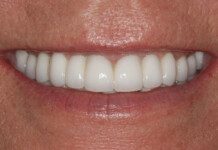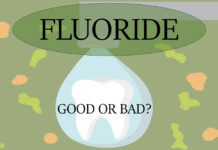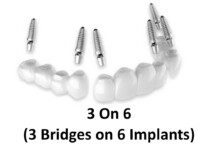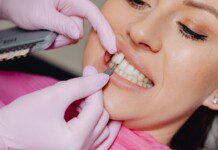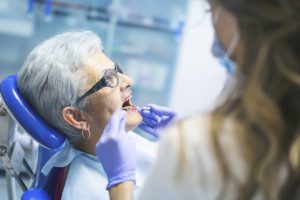
Dental problems for seniors is nothing new. As seniors advance in age, so do their teeth, oftentimes, resulting in declining oral health. Here’s a look at some of the most common dental problems in seniors.
DRY MOUTH
According to the American Dental Association, dry mouth in seniors is a leading cause of cavities. Dry mouth is not a normal part of aging, but it is a side-effect of over 500 medications as well as from certain health conditions, such as: diabetes, stroke, yeast infection (thrush) in your mouth, cancer therapy, Alzheimer’s disease, or autoimmune diseases, such as Sjogren’s syndrome or HIV/AIDS. Snoring and breathing with your mouth open also can contribute to dry mouth.
As we age, oftentimes the number and amount of medications we take increases. Thus, many seniors experience dry mouth. This is one reason your dentist asks about any medications you are taking. We can help suggest remedies and treatments for dry mouth to help reduce the irritation of it and risk of cavities. Dentists often recommend the following treatments:
- Drink more water
- Change medications when possible to one that doesn’t cause dry mouth
- Use a moisturizing mouthwash
- Chew sugar-free gum to stimulate saliva production
- Use a humidifier
- Moisturize your lips
- Get a fluoride treatment
- Avoid alcohol and coffee
- Avoid all tobacco
- Avoid over-the-counter antihistamines and decongestants
- Avoid sugary foods and candies (These increase the risk of tooth decay)
- Avoid mouthwashes containing alcohol
TOOTH DECAY AND LOSS
Just because you’ve got a few gray hairs doesn’t mean you’re out of the woods when it comes to cavities. The rate of tooth decay in people over 65 now outpaces that of schoolchildren. The most common target of dental cavities in older adults is around the base of the tooth, along or under the gum line. Seniors with dry mouth are extremely susceptible to this problem. So even if you’re one of those fortunate people who have gone most of your life without getting tooth decay, no matter how clean you keep your mouth, you are still at high risk of tooth decay being a problem. It may be recommended that your dental hygiene cleaning appointments are more frequent now than they’ve ever been before. This allows us to be able to keep a very close eye on this and immediately repair any cavities that develop while they’re very small, before they can do enough damage to require extensive treatment or removal.
GUM DISEASE
Gum disease, also known as periodontal disease, is another common dental problem for those over the age of 60. It’s caused by a bacteria found in plaque that irritates the gums and makes them swollen, red, and prone to bleeding. Gum disease is unique in that it’s relatively painless in the early stages. This causes it to be easily overlooked and left untreated.
Gum disease is best treated when it’s caught early, so it’s just as important to see your dentist regularly in old age as it is when you were younger.
ORAL CANCER
Mouth cancer is far more common than most people know. The American Cancer Society reports that over 54,000 cases of oral cancer are diagnosed each year. A vast majority of these cases are found in adults over the age of 60.
Dental visits often include screenings for oral cancer. Like gum disease, oral cancer is typically painless in the early stages so it can be easy to miss. However, early detection can save your life so it’s important to see your dentist in every stage of life.
OTHER DENTAL PROBLEMS
Other common dental problems in seniors include:
- Darkened teeth
- Decreased sense of taste
- Root decay
- Thrush
- Denture-induced stomatitis
- Uneven jaw bone
- Tooth loss
If you’re experiencing any of the above-mentioned issues, if you’re having problems with your teeth or prostheses, or or if you’d like to come in for an evaluation for anything related to your dental health, contact us today at 214-956-9100 and schedule a Complimentary Consultation (all necessary x-rays included).
SOURCES:

